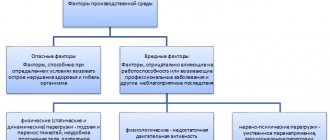What is written in the law
The need for medical examinations is established by two documents:
- Order of the Ministry of Health and Social Development of Russia dated April 12, 2011 No. 302n (hereinafter referred to as Order No. 302n)1.
- SanPiN 2.2.2/2.4.1340-032.
Clause 3.2.2.4 of Appendix No. 1 (hereinafter referred to as the List) of Order No. 302n requires medical examinations of employees exposed to the electromagnetic field of the broadband frequency spectrum from a PC at least once every 2 years. Working with a computer means reading, entering information, and interacting with a computer. Its duration must be at least 50 percent of working time. And it doesn't matter whether the employee works full time or not. In this case, only the video display terminal on a cathode ray tube (hereinafter referred to as CRT) generates electromagnetic radiation of a broadband frequency spectrum (in the range from 5 to 400 kHz). This explanation was given by the chief freelance occupational pathologist of the Ministry of Health and Social Development of Russia A. Yu. BUSHMANOVA.3 Consequently, liquid crystal screens and other modern monitors are not associated with the broadband spectrum. But you shouldn’t forget about a medical examination for office workers. Clause 13.1 of SanPiN 2.2.2/2.4.1340-03 (hereinafter referred to as SanPiN) requires persons who spend more than 50 percent of their working time at a computer to undergo preliminary and periodic medical examinations in the prescribed manner. However, there is no reference to the broadband spectrum of electromagnetic radiation.
Position of the courts
Courts indicate that employers are required to organize preliminary and periodic medical examinations for employees who work at computers. In this case, it does not matter whether the levels of the electromagnetic field of the broadband frequency spectrum in the workplace are exceeded according to the certification of workplaces or a special assessment. The only thing that matters is the fact of working at the computer more than 50 percent of the working time (resolution of the Arbitration Court of the East Siberian District dated May 19, 2015 No. F02-1878/2015, F02-2006/2015 in case No. A33-3164/2014, left in force without amendment by the Supreme Court of the Russian Federation).
Will they be punished for missing a medical examination?
If the employer does not send employees who work on computers with CRTs for a medical examination, he faces a fine in the amount of 110,000 to 130,000 rubles (Part 3 of Article 5.27.1 of the Code of Administrative Offenses of the Russian Federation). The State Labor Inspectorate can punish for this offense. And when employees work at computers with LCD screens, the absence of a medical examination will cost less - from 10,000 to 20,000 rubles (Article 6.3 of the Code of Administrative Offenses of the Russian Federation, decision of the Third Arbitration Court of Appeal dated April 2, 2012 in case No. A33-10404/2011) . But there remains a theoretical possibility of suspending the activities of an enterprise for up to 90 days. Rospotrebnadzor has the right to impose punishment under this article. Since the cost of a medical examination for one employee does not exceed 2,000–3,000 rubles, it is easier and cheaper to send employees for a medical examination than to have problems with the GIT or Rospotrebnadzor.
Requirements for premises for working with a computer
Today it is not uncommon to find workspaces with an area of only 10-12 square meters. m, which employs five to six people at a time. However, such working conditions are considered a gross violation of the rules established by SanPiN, according to which the required workspace for an employee who works with a computer for more than 50% of his working time depends on the type of monitor he uses:
- Based on an electro-ray tube, the working area for one worker must be at least 6 square meters. m;
- Plasma or LCD monitor - allows you to reduce this figure to 4.5 sq.m.
According to current recommendations, windows in such rooms are best located in the northern and northeastern parts. And if the production area does not have natural light, then the head of the company must provide employees with artificial lighting in the required amount. According to legal requirements, this requires special calculations, which is rarely done in practice.
The placement of employee desks is carried out in such a way that the distance between them is not less than 2 m, and between the side parts of the monitors - from 1.2 m. SanPiN also contains requirements regarding the degree of vibration, the intensity of sound and electromagnetic influences, as well as the microclimate in the room.
How to determine the duration of work at the computer
The duration of work at the computer must be recorded in the employer’s documents. If a dispute arises with regulatory authorities about the time spent at the computer, then the inspectors must prove their case.
Example
In one of the disputes, the court indicated that Rospotrebnadzor did not justify the need to conduct medical examinations of specific company employees who, according to Rospotrebnadzor, work at a computer more than 50 percent of their working time. During the inspection, the inspectors did not request or examine documents that would confirm their position. The court also indicated that the obligation to undergo a medical examination for all employees on the basis of clause 13.1 of SanPiN is not directly dependent on the type of activity of the employer (edition). Working with a PC is not the exclusive means of performing the job functions of these workers. The argument of Rospotrebnadzor that certain types of activities in the editorial office can only be performed on a PC (layout, proofreading, etc.) is speculative. The duration of such work was not measured (timing). A list of persons for whom working with a PC takes up less than 50 percent of their working time has not been compiled, therefore the conclusion that the employer violated these rules cannot be considered justified (decision of the Moscow Arbitration Court dated November 28, 2006, December 5, 2006 in case No. A40-67021/06-146-489). You can confirm the time you work at the computer using timekeeping. The procedure for its implementation is not established by law. The employer has the right to independently develop such a procedure and consolidate it, for example, in local regulations. It also regulates the methods and means of recording and the procedure for reflecting the results of observations. Separately, an order is issued to appoint responsible persons.
Example
In another dispute, a higher court overturned a lower court's decision. The conclusions of colleagues that the timekeeping reports submitted by the employer do not confirm the presence of employees who spend more than 50 percent of their working time at the computer are not correct. The court did not take into account that Rospotrebnadzor must prove the employer’s guilt. He also had to present evidence of his position in court, which Rospotrebnadzor did not do (resolution of the Third Arbitration Court of Appeal dated August 24, 2009 No. A33-9135/2009-03AP-3026/2009 in case No. A33-9135/2009). Other documents confirming the time spent working at the computer may be:
- job descriptions;
- schedules of meetings, meetings and business trips of employees;
- electronic journals recording technical parameters of working with a computer;
- testimony of witnesses (including employees' managers);
- time sheets, etc.
In this case, timing must be carried out over the course of the entire working day for at least one working week4. This is due to the fact that in most cases, without significant damage to the work schedule, an employee can be at the computer less than 50 percent of the time on the day of measurements. And then the measurements lose objectivity. As a conclusion, it can be noted that preliminary and periodic medical examinations should be carried out for all workers who spend most of their working time at the computer, regardless of the quality of the monitors and the results of a special assessment, if any.
Lighting in the workplace
The rules for lighting rooms in which workers who use computers work are given special attention in SanPiN. This is due to the fact that the degree of visual fatigue directly depends on the intensity of lighting.
According to the requirements of the Sanitary Rules, it is better to place sources of natural light on the north, north-east side of the room. It is recommended to organize artificial lighting using fluorescent lamps shaped like lines (solid or broken). They should be installed on the side of the working surface, and in case of circular placement of work stations - localized, above the table, closer to the operator. The level of local illumination on the working surface should be within 300-500 lux.
Does the need for medical examinations depend on the results of the special assessment?
Another controversial point is the question of whether it is necessary to conduct a medical examination if, based on the results of a special assessment, the harmfulness has not been established and the working conditions are considered acceptable. In this case, the positions of the Ministry of Labor and Rospotrebnadzor differ.
What is the opinion of the Russian Ministry of Labor and Rospotrebnadzor?
The Ministry of Labor, referring to paragraph 3.2.2.4 of the List, believes that mandatory preliminary and periodic medical examinations are carried out if:
- at the workplace there is an electromagnetic field of a broadband frequency spectrum from a PC;
- work on reading, entering information, etc. totals at least 50 percent of the working time.
In this case, the results of workplace certification or special assessments do not matter (letter of the Russian Ministry of Labor dated March 21, 2014 No. 15-2/OOG-242). The same position is shared by a number of courts (decision of the Supreme Court of the Russian Federation dated September 24, 2015 No. 302-KG15-11278 in case No. A33-3164/2014). However, Rospotrebnadzor has a different position: if the class of working conditions is acceptable, then a medical examination is not carried out for this factor (letter of Rospotrebnadzor dated June 19, 2015 No. 01/7015-15-31).
What the law says
Let's compare the positions of supervisory agencies with regulations. The lists of contingents and names for medical examinations must include workers who are exposed to:
- harmful production factors specified in the List;
- harmful production factors, the presence of which was established based on the results of workplace certification (special assessment)5.
List6 lists factors that:
- are considered harmful if they are assigned such a status during workplace certification or special assessment (for example, paragraph 4.4.2 – size of the object of distinction);
- classified as harmful and (or) dangerous classes initially, in accordance with current regulations, regardless of the results of workplace certification or special assessment.
At the same time, in paragraph 3.2.2.4 of the List there is no reference to the results of certification (special assessment). Therefore, this factor is harmful due to its presence. Therefore, the position of the Russian Ministry of Labor is the most convincing.
Remember the main thing
1
Employees exposed to broadband electromagnetic fields from PCs must undergo a medical examination at least once every 2 years.
2
If an employee works at a computer with an LCD monitor, the decision on the need to conduct a medical examination will depend on the duration of his work at the PC.
3
Rostrud and the Ministry of Labor of Russia have opposing points of view on the need to conduct a medical examination.
However, the Russian Ministry of Labor takes a more correct position. 4
The duration of work at the computer is confirmed by local regulations, timing, schedules of meetings, business trips, testimony of witnesses, etc. Order of the Ministry of Health and Social Development of Russia dated April 12, 2011 No. 302n “On approval of lists of harmful and (or) hazardous production factors and work, during which mandatory preliminary and periodic medical examinations (examinations) are carried out, and the Procedure for conducting mandatory preliminary and periodic medical examinations (examinations) of workers engaged in heavy work and work with harmful and (or) dangerous working conditions.” 2Resolution of the Chief State Sanitary Doctor of the Russian Federation dated June 3, 2003 No. 118 “On the implementation of sanitary and epidemiological rules and regulations SanPiN 2.2.2/2.4.1340-03.” 3Letter of the Ministry of Health and Social Development of Russia dated April 30, 2013 No. 12-02/929. 4Р 2.2.2006-05. Guidelines for hygienic assessment of working environment and labor process factors. Criteria and classification of working conditions (approved by the Chief State Sanitary Doctor of the Russian Federation on July 29, 2005). 5The procedure for conducting mandatory preliminary (upon entry to work) and periodic medical examinations (examinations) of workers engaged in heavy work and work with harmful and (or) dangerous working conditions (approved by order of the Ministry of Health and Social Development of Russia dated April 12, 2011 No. 302n). 6Approved by order of the Ministry of Health and Social Development of Russia dated April 12, 2011 No. 302n. Andrey SLEPOV, senior lawyer, head of the international legal practice of labor and migration law (Moscow).
ESSENCE OF CHANGES
Both the previous and the new editions of clause 3.2.2.4 indicate the same name of the harmful factor - electromagnetic field of the broadband frequency spectrum (hereinafter referred to as EMF) (example 2).
As we can see, the changes affected only the conditions under which the effect of this factor is considered harmful. If in the previous edition it was important how much time an employee spends at the computer, then in the new version only compliance with hygienic standards in the specified radiation range is taken into account. The computer is not indicated as a source of EMF at all.
As a result, it is significantly easier to make a decision on whether to include clause 3.2.2.4 in the list of workers subject to periodic and (or) preliminary inspections (hereinafter referred to as the list of workers) or not, since information about the compliance or non-compliance of EMF parameters with maximum permissible levels (hereinafter – Remote control) can be easily found in the SOUT and production control protocols. You don’t even need to know the value of the MPL, since the expert has already calculated everything and made conclusions (see example 3).
SOURCES OF EPM
Exposure to EMF occurs whenever and wherever a person is exposed to electric, magnetic or electromagnetic fields or contact currents other than those arising during physiological processes and other natural phenomena. Since 2011, when Order No. 302n came into effect, not only has the number of operating EMF sources increased, but also the scope of application of technology that creates electromagnetic fields in the surrounding space has expanded.
Therefore, the range of 5 Hz–400 kHz may also include fields whose sources are unbalanced currents (leakage currents) of 0.4 kV power supply systems, including electrical wiring, electrical equipment installed in buildings, including transformers, cable lines, distribution shields (see figure).
The magnetic field induces eddy currents in the human body. They are the main mechanism of biological action and can cause changes in the functional state of the nervous, cardiovascular, and immune systems. Therefore, in order to cancel the medical examination under clause 3.2.2.4, in the measurement protocols at the workplaces of your colleagues, the EMF parameters in the range of 5 Hz - 400 kHz should not exceed the maximum permissible limit, regardless of the source of their formation.
Express News
For work in hazardous working conditions, additional payments and additional leave are provided. Pregnant and breastfeeding women are not allowed!
Head of the Department of Radiation Medicine and Ecology of the Belarusian State Medical University, Professor Alexander Stozharov: - Electromagnetic fields are emitted by all parts of the computer, including the mouse, but the monitor poses the greatest danger. LCD monitors are the safest from this point of view.
In general, I would recommend that everyone who works at a computer undergo an annual medical examination, even if there are no signs of health problems.
For working in harmful and/or dangerous working conditions, and these happen, it turns out, not only in the mine, but also in the office, you are entitled to additional pay and additional days of vacation.
However, it is not so easy to obtain them. Deputy Head of the Department of State Expertise of Working Conditions of the Ministry of Labor and Social Protection Tatyana Garayeva spoke about the procedure for certifying workplaces according to working conditions: Certification involves a comprehensive assessment of all harmful and/or dangerous factors in the working environment present at a particular workplace. Currently, all design documentation for industrial buildings under construction is being approved by our department, so as not to create jobs with obviously harmful working conditions.
- Tatyana Vasilievna, let's look at this case.
A person came to work, for example, as an accountant.
His workplace is equipped with a computer and printer. Is he entitled to extra pay for working on a computer? — Is his workplace certified? — How long do you have to work in harmful conditions to get extra pay for working on a computer? — Who should be on the workplace certification commission? Probably not every enterprise has specialists capable of measuring production environment factors?
— Is the validity period for workplace certification determined? — Tatyana Vasilievna, where can employers, especially representatives of small businesses, learn about the procedure for certification of workplaces?
— Let’s say it turned out that not a single workplace equipped with a computer at the enterprise is certified, and workers do not receive additional payment... Deputy Head of the Labor Safety Department of the Ministry of Labor and Social Protection of the Republic of Belarus Vladimir Dydyshko says:
Extra charge (surcharge?) for working on a computer
Since 1998, I have been working at a municipal educational institution (Children and Youth Center) - first as a part-time worker, then as a full-time employee.
And I was always paid the above allowance.
While they were paying this premium, I was not interested in what grounds it was, but when they took it away, it immediately became interesting! ) Question: what regulations regulate the additional payment for computer work in the amount of 12%?
(if you need a local NA, then in what form and what to refer to in it, i.e.
On the basis of what federal or industry regulations it, local, was compiled). One of the factors is working behind computer displays; in the list of hazardous working conditions for which bonuses are due, there is indeed such an item.
Work breaks
In order to prevent increased fatigue of employees working with computers, clause 1.3 of Appendix No. 7 to SanPiN recommends, when developing work shifts, to alternate activities with and without the use of a PC. If the work involves constant contact with computer equipment, then breaks in the work of employees should be organized for 10-15 minutes every hour. According to Part 1 of Article 109 of the Labor Code of the Russian Federation, these breaks are included in working time, and during night shifts, the duration of rest increases by 30%.
Sanitary rules recommend organizing “physical training” minutes for employees in order to reduce their psychophysical stress and prevent physical inactivity and hypokinesia.









